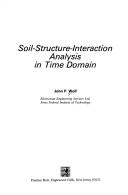| Listing 1 - 10 of 37 | << page >> |
Sort by
|
Book
ISBN: 0080171362 9780080171364 Year: 1973 Publisher: Oxford Pergamon
Abstract | Keywords | Export | Availability | Bookmark
 Loading...
Loading...Choose an application
- Reference Manager
- EndNote
- RefWorks (Direct export to RefWorks)
Book
Year: 1960 Publisher: New York (N.Y.): Wiley,
Abstract | Keywords | Export | Availability | Bookmark
 Loading...
Loading...Choose an application
- Reference Manager
- EndNote
- RefWorks (Direct export to RefWorks)
Book
Year: 1964 Publisher: New York, N.Y.: McGraw-Hill,
Abstract | Keywords | Export | Availability | Bookmark
 Loading...
Loading...Choose an application
- Reference Manager
- EndNote
- RefWorks (Direct export to RefWorks)
Book
ISBN: 9780415620864 0415620864 Year: 2012 Publisher: Boca Raton (Fla.): CRC,
Abstract | Keywords | Export | Availability | Bookmark
 Loading...
Loading...Choose an application
- Reference Manager
- EndNote
- RefWorks (Direct export to RefWorks)
Book
Abstract | Keywords | Export | Availability | Bookmark
 Loading...
Loading...Choose an application
- Reference Manager
- EndNote
- RefWorks (Direct export to RefWorks)
Book
Abstract | Keywords | Export | Availability | Bookmark
 Loading...
Loading...Choose an application
- Reference Manager
- EndNote
- RefWorks (Direct export to RefWorks)
Book
ISBN: 1118770706 9781118770702 Year: 2024 Publisher: Hoboken: Wiley,
Abstract | Keywords | Export | Availability | Bookmark
 Loading...
Loading...Choose an application
- Reference Manager
- EndNote
- RefWorks (Direct export to RefWorks)
"The very first idea for this book came, some years ago, from Alex Carrella, who at the time was a young postdoctoral researcher, working within a University Technology Centre, integrating a group focused on applied research for a specific industry. In that case it was about vibration of helicopters. The partnership between academia and industry meant that an academic had to use the engineering pragmatism to solve some pressing issues, while practising engineers embrace the more rigorous and lengthier yet innovative practice of academia. Needless to say, the result is a fast transfer of technology to the industry and a much- needed flow of funds to academia to advance knowledge, as resources are of primary importance. For instance, in the process of preparing, carrying out and post-processing the data of a Ground Vibration Test (GVT) there were many questions to be answered, all within the science of structural dynamics, but related to different disciplines, each of them in a different book (or several books on the subject). A pragmatic approach would have been to have one tome with all that was needed enabling the counterpart in the industry to have a book on one's desk where he/she could dig a little deeper and have a more theoretical notion on a specific subject. Hence the idea of creating a volume to be kept on the desk of practising engineers and 'appliedresearchers' for having a reference for most topics related to structural dynamics. However, to create a book on the subject of structural dynamics particularly interesting to the industry is quite an ambitious objective to achieve, as the industry seeks the necessary knowledge to make things happen in a relatively fast way, the so-called "know-how", whereas academics explore the theoretical foundations to explain the physical phenomena, what one may call the "know-why". To find the right balance between these two perspectives is not an easy task. Although most of the co-authors of this textbook are scholars, they have the notion of the industrial environment and of the needs of those involved in the daily practice, sometimes due to some industrial experience, or because of close participation in research projects involving various types of companies. Structural Dynamics is a vast world and no book can encompass the wide variety of themes. Each subject can become a book on its own. Therefore, a judicious choice had to be made and it was decided that the book would have 7 chapters, where Chapter 1 underlines the main fundamental aspects of vibration theory, from the very simple single degree of freedom system to the more general multiple degree of freedom, pointing out relevant aspects that are used in practice; Chapter 2 addresses the main practical problems that may be found in testing a structure, analysing the results and how to tackle the encountered issues in order to solve them; Chapter 3 presents the most important numerical tools that are commonly used and provides the necessary insight on how the various methods work; Chapter 4 describes in detail methods of analysing the results from dynamic tests and how to identify the dynamic properties, so to build a reliable mathematical model that represents the behaviour of a structure when in real operational conditions; Chapter 5 gives a comprehensive and solid background on the nonlinear behaviour of a system, as often the nonlinear aspects cannot be ignore by the analyst engineer."--
Periodical
ISSN: 13704184 Year: 1992 Publisher: Bruxelles : CSTC ( = Centre scientifique et technique de la construction),
Abstract | Keywords | Export | Availability | Bookmark
 Loading...
Loading...Choose an application
- Reference Manager
- EndNote
- RefWorks (Direct export to RefWorks)
Building --- Structural dynamics --- Architecture --- Building. --- Architecture. --- Structural dynamics. --- Building - Periodicals

ISBN: 0138229740 9780138229740 Year: 1988 Publisher: Englewood Cliffs : Prentice-Hall International,
Abstract | Keywords | Export | Availability | Bookmark
 Loading...
Loading...Choose an application
- Reference Manager
- EndNote
- RefWorks (Direct export to RefWorks)
Soil dynamics. --- Structural dynamics. --- Time-domain analysis.
Book

ISSN: 03796566 ISBN: 929092831X 9789290928317 Year: 2003 Volume: 521 Publisher: Noordwijk : ESA publications division,
Abstract | Keywords | Export | Availability | Bookmark
 Loading...
Loading...Choose an application
- Reference Manager
- EndNote
- RefWorks (Direct export to RefWorks)
| Listing 1 - 10 of 37 | << page >> |
Sort by
|

 Search
Search Feedback
Feedback About
About Help
Help News
News